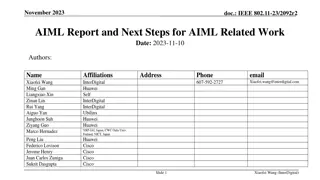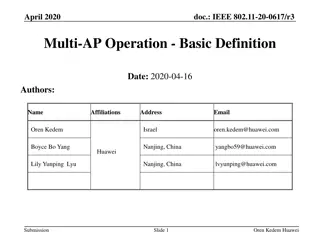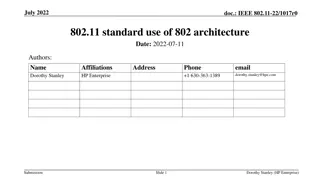IEEE 802.11-19/1358r5 Multi-Link Operation Management Overview
This document provides insights into the multi-link operation management proposed for IEEE 802.11-19/1358r5 standard by MediaTek Inc. The concept involves handling multi-link entities, such as APs and STAs, for improved performance in different environments. It discusses the architecture, motivations, and signaling mechanisms related to multi-link operations to enhance QoS, load balancing, and power savings in wireless networks.
Download Presentation

Please find below an Image/Link to download the presentation.
The content on the website is provided AS IS for your information and personal use only. It may not be sold, licensed, or shared on other websites without obtaining consent from the author.If you encounter any issues during the download, it is possible that the publisher has removed the file from their server.
You are allowed to download the files provided on this website for personal or commercial use, subject to the condition that they are used lawfully. All files are the property of their respective owners.
The content on the website is provided AS IS for your information and personal use only. It may not be sold, licensed, or shared on other websites without obtaining consent from the author.
E N D
Presentation Transcript
November 2020 doc.: IEEE 802.11-19/1358r5 Multi-Link Operation Management Date: 2020-10-31 Authors: Name Affiliations Address Phone email 2840 Junction Ave, San Jose, CA 95134 yongho.seok@mediatek .com Yongho Seok MediaTek Inc. Kaiying Lu MediaTek Inc. Gabor Bajko MediaTek Inc. James Yee MediaTek Inc. Jianhan Liu MediaTek Inc. Thomas Pare MediaTek Inc. Submission Slide 1 Yongho Seok, MediaTek
November 2019 Recap: Multi-link logical entity (MLLE) architecture [1] doc.: IEEE 802.11-19/1358r5 A logical entity that has one or more affiliated STAs. The logical entity has one MAC data service interface and primitives to the LLC and a single address associated with the interface, which can be used to communicate on the DSM. Multi-link AP logical entity AP1 operating on 2.4 GHz AP2 operating on 5 GHz AP3 operating on 6 GHz Link 1 Link 2 Link 3 Non-AP STA1 Non-AP STA2 Non-AP STA3 Multi-link non-AP logical entity Submission Slide 2 Yongho Seok, MediaTek
November 2019 doc.: IEEE 802.11-19/1358r5 Motivation This contribution proposes how to manage multi-link for QoS, load-balancing and power saving. Submission Slide 3 Yongho Seok, MediaTek
November 2019 doc.: IEEE 802.11-19/1358r5 Motivation Multi-link operation can improve the per-session peak throughput by exchanging frames on multiple links, in a non-congested environment. Also, in a congested environment, it can improve the spectrum efficiency by more dynamically balancing the traffic load over multiple links. The AP dynamically determines for each non-AP STA one or more links on which frames can be exchanged or not. As the AP informs those updates, the non-AP STA moves its operation links for the load balancing purpose. Submission Slide 4 Yongho Seok, MediaTek
November 2019 doc.: IEEE 802.11-19/1358r5 Motivation The non-AP STA may also need to dynamically signal one or more links on which frames can be exchanged or not. The non-AP STA can signal that more links can be used for frame exchanges when it has more buffered traffic. Or, the non-AP STA can signal that one or more links can t be used for frame exchanges for the purpose of power saving and in- device resource management. Submission Slide 5 Yongho Seok, MediaTek
November 2019 doc.: IEEE 802.11-19/1358r5 Motivation This contribution proposes a signaling to dynamically enable/disable multiple link(s). Supported multi-link set Negotiated multi-link set Disabled multi-link set [Can be turned off] Enabled multi-link set [Follow existing PSM] Submission Slide 6 Yongho Seok, MediaTek
November 2019 doc.: IEEE 802.11-19/1358r5 Terminologies Supported multi-link set: One or more links on which the multi-link operation is supported. Negotiated multi-link set: One or more links on which the multi-link operation set up is negotiated. Enabled multi-link set: One or more links on which frames can be exchanged through the multi-link operation. Disabled multi-link set: One or more links on which frames can t be exchanged through the multi-link operation. Submission Slide 7 Yongho Seok, MediaTek
November 2019 doc.: IEEE 802.11-19/1358r5 Multi-link Operation Management (1/3) An MLLE identifies which links of the peer MLLE support the multi-link operation during the multi-link operation setup phase. The MLLE also exchanges the multi-link capabilities (e.g., the in- device coexistence interference level) during the multi-link operation setup phase. Submission Slide 8 Yongho Seok, MediaTek
November 2019 doc.: IEEE 802.11-19/1358r5 Multi-link Operation Management (2/3) After the multi-link operation setup, an MLLE (an AP MLLE or a non-AP MLLE) may determine to change the enabled multi-link set associated with the peer MMLE for each TID/all TIDs. The enabled multi-link set of the non-AP MLLE shall be one or more links in the negotiated multi-link set of the non-AP MLLE. In such case, The MLLE performs a negotiation in TBD format with the peer MLLE, to update the current enabled multi-link set. When the responding MLLE can t accept this updated, it can reject the change of the enabled multi-link set. Submission Slide 9 Yongho Seok, MediaTek
November 2019 doc.: IEEE 802.11-19/1358r5 Multi-link Operation Management (3/3) The AP MLLE and the non-AP MLLE can exchange frames using the MLO only on link(s) which are in the enabled multi-link set, subject to STA power states. For the purpose of power saving and other resource management, On the enabled multi-link set, the existing per-link power management mechanisms can be utilized. On the disabled multi-link set, the non-AP MLLE can turn off the radio. Submission Slide 10 Yongho Seok, MediaTek
November 2019 doc.: IEEE 802.11-19/1358r5 Multi-link Operating Example After the multi-link setup, the enabled multi-link set can be updated, which can be initiated by any MLLE. Contains Info on enabled link 1, 2 Contain Info on enabled link 1 Contains Info on enabled link 1, 2, 3, 4 Data frame exchange Multi-link Update Exchange Data frame exchange Multi-link Association Exchange Data frame exchange Multi-link Update Exchange Link1 Peer MLLE rejects this update. Peer MLLME accepts this update. Data frame exchange Data frame exchange Data frame exchange Link2 Enabled multi-link Enabled multi-link Data frame exchange Link3 Data frame exchange Link4 Enabled multi-link Submission Slide 11 Yongho Seok, MediaTek
November 2019 doc.: IEEE 802.11-19/1358r5 Conclusion In this contribution, we propose the signaling mechanism for dynamically update the enabled multi- link set and the disabled multi-link set. Submission Slide 12 Yongho Seok, MediaTek
November 2019 doc.: IEEE 802.11-19/1358r5 References [1] https://mentor.ieee.org/802.11/dcn/19/11-19-0773-03- 00be-multi-link-operation-framework.pptx Submission Slide 13 Yongho Seok, MediaTek
November 2019 doc.: IEEE 802.11-19/1358r5 SP1 Do you support the following multi-link operation? Define a directional-based TID-to-link mapping mechanism among the setup links of a multi-link logical device (MLD). By default, after the multi-link setup, all TIDs are mapped to all setup links. The multi-link setup may include the TID-to-link mapping negotiation. TID-to-link mapping can have the same or different link-set for each TID unless a non-AP MLD indicates that it requires to use the same link-set for all TIDs during the multi-link setup phase. NOTE: Such indication method by the non-AP MLD is TBD (implicit or explicit). The TID to link mapping can be updated after multi-link setup through a negotiation, which can be initiated by any MLD. Format TBD Note: When the responding MLD can not accept the update, it can reject the TID link mapping update. Submission Slide 14 Yongho Seok, MediaTek
November 2019 doc.: IEEE 802.11-19/1358r5 SP2 Do you support to amend the TGbe SFD as the following? In R1, 802.11be defines a directional-based TID-to-link mapping mechanism among the setup links of a MLD. By default, after the multi-link setup, all TIDs are mapped to all setup links. The multi-link setup may include the TID-to-link mapping negotiation. TID-to-link mapping can have the same or different link-set for each TID unless a non-AP MLD indicates that it requires to use the same link-set for all TIDs during the multi-link setup phase. NOTE Such indication method by the non-AP MLD is TBD (implicit or explicit). The TID-to-link mapping can be updated after multi-link setup through a negotiation, which can be initiated by any MLD. Format TBD. NOTE When the responding MLD cannot accept the update, it can reject the TID- to-link mapping update. The support of the TID-to-link mapping negotiation is optional. [Motion 54, [29] and [169]] Submission Slide 15 Yongho Seok, MediaTek























